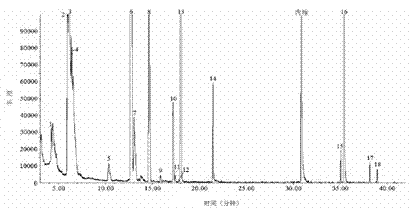Method for trapping mymaridae parasitized empoasca vitis
A technology of false-eyed green leafhopper and tassel wasp, applied in botany equipment and methods, chemicals for biological control, biocides, etc., can solve the problem of lack of feeding, breeding, and insufficient control of leafhoppers, etc. problems, to achieve the effect of protecting and utilizing natural enemy resources, low cost, and quick results
- Summary
- Abstract
- Description
- Claims
- Application Information
AI Technical Summary
Problems solved by technology
Method used
Image
Examples
Embodiment 1
[0024] Example 1 Developing an attractant and trying it to attract wasps and control the green leafhopper with false eyes
[0025] Step 1: Separation and identification of volatiles from healthy and cicada-damaged tea plants and volatiles from healthy and oviposition-damaged tea plants
[0026] Put the above-ground parts of potted healthy tea tree plants, the above-ground parts of leafhopper-sucked tea tree plants, healthy tender stems, and tender stems stabbed by ovipositors into clean glass covers, and clean air is introduced from the air inlet to entrain The tea tree odor flows through the Super Q adsorption column connected to the air outlet, and the dynamic adsorption is 8 After 10 hours, the adsorption column was rinsed with chromatographically pure dichloromethane, and the eluate was slowly concentrated to about 20 μl under high-purity nitrogen flow. Draw 1μl and analyze it by gas-mass spectrometer, cooperate with the standard sample for qualitative determination...
Embodiment 2
[0043] Example 2 Detection of the attractiveness of tea tree mutene to the wasps
[0044] 1 Detection method
[0045] Using n-hexane as solvent, prepare 10 - 2 g / ml dosage α -farnesene, benzaldehyde, trans-2-hexenal, β -Farnesene, methyl salicylate and cis-jasmone solution, with n-hexane as a contrast, get an equal amount of benzaldehyde solution and cis-jasmone solution to form a mixture. Soak 1 bud and 2 tea leaves imitated by rubber materials in these 8 kinds of solutions for 24 hours, take them out and dry them in the air to make lures.
[0046] The number of bees gradually increased in autumn. The Meijiawu Village, the origin of West Lake Longjing in Hangzhou City, was selected for the experiment on September 11, 2010. Each lure was placed in the tea garden from 10:30 to 12:30, and each lure The core is attached to a sheet of 20 cm 40 cm bud green sticky board, there is no lure on the other side of the color board, the color board is tied to a small bamboo po...
Embodiment 3
[0051] Example 3 Detecting attractants to increase the parasitism rate of the wasps to the eggs of Leafhopper chrysalis
[0052] 1 Detection method
[0053] On October 3, 2010, in the organic tea garden in the Jingting Mountain Scenic Area of the Jingting Mountain Tea Farm in Anhui Province, Leafhoppers Tricotidae and Tiny Craniospermia have been harvested. Then this piece of organic tea garden is divided into two parts, the area of the upwind part is about 5 667m 2 , as a trapping area, the area of the other part of the downwind vent is about 5 667m 2 As the CK area, no lures are placed, and the distance is 300 m.
[0054] On the morning of October 3, 1-bud and 5-leaf tea shoots with egg-laying thorns on the surface of the tender stems were randomly cut from the two tea gardens, and returned to the room. on moistened filter paper in a large Petri dish placed in a light incubator. Light incubator temperature 25 ± 3 ℃, relative humidity 70 ± 5%, light 32000 ...
PUM
 Login to View More
Login to View More Abstract
Description
Claims
Application Information
 Login to View More
Login to View More - R&D
- Intellectual Property
- Life Sciences
- Materials
- Tech Scout
- Unparalleled Data Quality
- Higher Quality Content
- 60% Fewer Hallucinations
Browse by: Latest US Patents, China's latest patents, Technical Efficacy Thesaurus, Application Domain, Technology Topic, Popular Technical Reports.
© 2025 PatSnap. All rights reserved.Legal|Privacy policy|Modern Slavery Act Transparency Statement|Sitemap|About US| Contact US: help@patsnap.com



